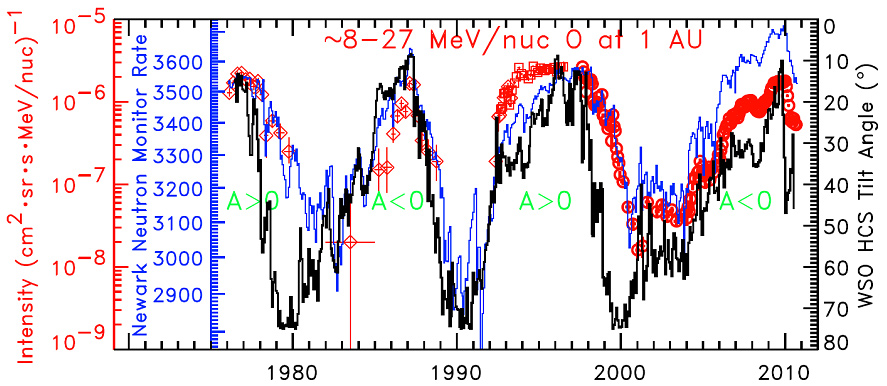
| ACE News Archives | ACE News #136 - November 23, 2010 |
Subscribe to ACE News |

Comparison of the ACR intensity (red data points; first left axis, circles since 1997 are from ACE/SIS) and the Newark neutron monitor count rate (blue curve; second left axis) with the HCS tilt angle from the Wilcox Solar Observatory "classic" model (http://wso.stanford.edu; thick black curve; right axis -- note inverted scale) over the past several solar cycles.
Anomalous cosmic rays (ACRs) are accelerated in the outer heliosphere from pick-up ions that primarily originate as interstellar neutrals. Like the galactic cosmic rays (GCRs), their intensities are altered during their journey to the inner heliosphere, and thus they provide an important probe of solar modulation processes. ACR intensities at 1 AU at solar minimum generally track GCR intensities such as those measured by neutron monitors, with differences between solar polarity cycles. As shown in the figure, although GCRs were at record high intensities this solar minimum (see Mewaldt et al. ApJL 723, L1, 2010 and ACE News #122 & #134), ACR intensities at 1 AU were not. In fact they were quite typical, with peak intensities similar to those during the last A<0 polarity minimum in the mid-1980's and below those of the A>0 minimum ~11 years ago. Voyager measurements in the outer heliosphere show that the intensity of high energy ACRs was the same this solar minimum as in the mid-1980's, suggesting that the ACR source intensity was unaffected by the unusual interplanetary conditions discussed in ACE News #134, such as the weak magnetic field and reduced solar-wind dynamic pressure.
During A<0 cycles (when the Sun's magnetic field points inward in the northern hemisphere) ACRs drift into the inner heliosphere along the heliospheric current sheet (HCS) (Jokipii & Thomas, ApJ 243, 1115, 1981), and as the figure indicates there was a striking correlation between the HCS tilt angle, ACR intensities, and GCR (neutron monitor) intensities during the 1980's A<0 epoch. Prior to 2000, the major, prolonged deviations between the tilt angle and cosmic ray intensities occur during the approach to solar maximum from the two A>0 minima, when GCR and ACR rates declined only slowly as the tilt angle rapidly increased. This is as expected: particles drift in from the polar regions of the heliosphere during A>0 periods and are virtually unaffected by changes in the near-equatorial HCS. However, after the last field reversal in ~2000, the GCRs, ACRs, and HCS tilt angle no longer scale as they did in the previous three solar minima. For a given tilt angle, both GCR and ACR intensities are elevated compared with the last A<0 solar minimum, but GCRs are relatively more enhanced than ACRs. The long, deep solar minimum allowed for less cosmic ray modulation, but the relatively high HCS tilt angle partially compensated for this. If the ACR source distribution is concentrated at low latitudes during A<0 periods as theory suggests (Jokipii & Giacalone, Space Sci. Rev. 83, 123, 1998), ACRs may be more sensitive to high tilt angles than GCRs are. Resolving the puzzle of how solar modulation can yield record high GCR intensities without affecting the ACRs will help us better understand the underlying physics of solar modulation and may constrain theories of the origin of ACRs.
For more information, see the paper by Leske et al. that has been submitted to Space Science Reviews.
This item was contributed by Rick Leske, Alan Cummings, Dick Mewaldt, and Ed Stone of Caltech. Address questions and comments to
Last modified 23 Nov 2010.